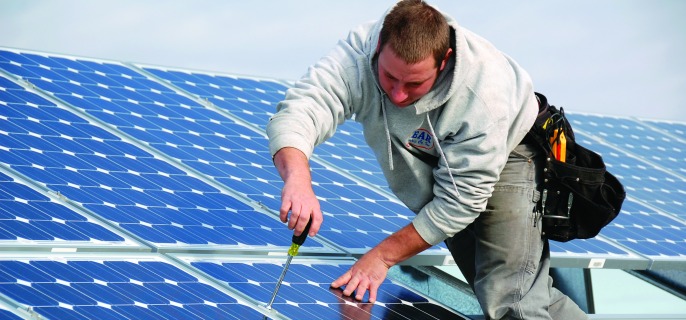
Umatilla Electric Cooperative is exploring whether to build one or more solar projects within its service territory in the next two years.
Several factors play in the decision to consider solar generation opportunities, said Steve Eldrige, UEC General Manager and CEO.
Solar costs are dropping, a solar investment tax credit is set to phase out at the end of 2016, and UEC faces a state mandate that will require UEC to purchase renewable energy in the near future.
“Solar energy costs may be approaching a tipping point,” Eldrige said. “We are exploring whether we can make this investment on behalf of our Members without raising their cost of electricity.”
UEC installed a 57-kilowatt solar array next to its Hermiston headquarters in December 2009. During the past five years, the small demonstration project has produced about 80,000 kilowatt-hours of power annually, enough to power the equivalent of five all-electric homes.
Today, solar capital costs have fallen 50 percent or more compared to when UEC installed its demonstration project, Eldrige said. “If we build larger, there will be economies of scale,” he said. “If we levelize the investment over the life of installation, we believe it may be affordable in the near term as well as for many years in the future.”
When designated as a large utility under Oregon’s Renewable Portfolio Standards law, UEC will be required to seek out sources of “new” renewables such as wind or solar to provide a portion of its power supply. “This is a preparation for that requirement, and it may be better to act now than waiting until the requirement is implemented in the next four to six years,” Eldrige said.
Any UEC investments would be timed to benefit from the federal 30-percent solar Investment Tax Credit, designed to encourage residential and commercial solar installations in the U.S. The legislation also permits utilities to use the credit.
First implemented in 2006, the tax credit primarily covers capital installation costs and is scheduled to be lowered to 10 percent after 2016.
“Members can be assured that we will seek their input and keep them informed as we consider whether or not to make this investment,” Eldrige said. “Solar has caught the imagination of the general public and cost effectiveness of the technology is improving, so we will explore its feasibility here in our service area.”








